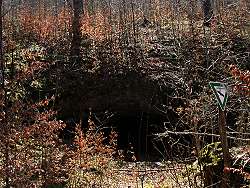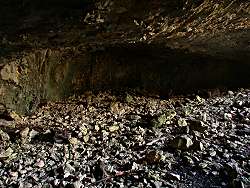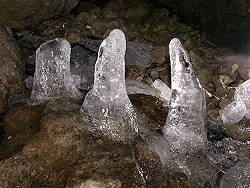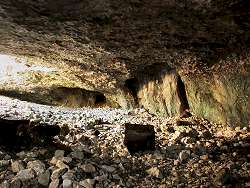Hohler Stein
Useful Information


| Location: |
89150 Laichingen.
A8 Ausfahrt Merklingen, towards Laichingen, then B28 to Feldstetten. Before the village turn right towards Laichingen, after 1.5 km turn right on single lane road uphill to the forest. 10 miuntes walk. (48.4798994, 9.6542406) |
| Open: |
No restrictions. [2023] |
| Fee: |
free. [2023] |
| Classification: |
 Karst Cave Karst Cave
 Ice Cave Ice Cave
|
| Light: | bring torch |
| Dimension: | L=12 m, W=22 m, H=2.7 m, Ar=260 m², A=785 m asl. Portal: H=3 m, W=12 m. |
| Guided tours: | self guided |
| Photography: | allowed |
| Accessibility: | no |
| Bibliography: |
Richard Frank (1988):
Die Höhlen der Gemarkung Laichingen,
Laichinger Höhlenfreund 23(2) 1988, S. 57-88.
|
| Address: |
Touristinformation Blaubeuren, Kirchplatz 10, 89143 Blaubeuren, Tel: +49-7344-9669-90.
E-mail: |
| As far as we know this information was accurate when it was published (see years in brackets), but may have changed since then. Please check rates and details directly with the companies in question if you need more recent info. |
|
History
| 07-MAY-2003 | declared a Naturdenkmal (Natural Monument). |
Description


The Hohle Stein (Hollow Stone) is the ruin of a former, lower-lying cave chamber. This may have been part of a large cave system that led water from the surrounding area towards the Urlauter river in the Eberstal valley. Several processes of weathering caused the ceiling to become thinner and more unstable: corrosion, i.e. chemical dissolution by CO2-rich water, erodes limestone on the surface. The deepening of the valley, which is now a dry valley, also lowered the surface. At the same time, the cave migrates upwards, so to speak, as rocks break off the ceiling and deposit on the cave floor. Both processes lead to a thinning of the ceiling, so that it eventually collapses. The result is then called a sinkhole or collapse doline. It is very common in karst areas, but usually the underlying cave is filled in or destroyed and is not accessible after the collapse. In the case of the Hohle Stein, the cavity was large enough that it was only partially filled by the collapse.
The Hohle Stein has only one large hall, which is 12 metres long and 22 metres wide. The floor area is 260 m². It is therefore in German sometimes called a Überdachungshöhle (roof cave), but this term is outdated and not common anymore. Today, it is more commonly referred to as a cave shelter.
Due to frost weathering deep into the chamber, blocks have been detached from the ceiling and are piled up on the floor. According to local lore the Hohle Stein was so spacious that they could turn around inside with a hay wagon. This shows that such cave ruins change relatively quickly, today the cave would be too small. Eventually only a shallow depression will remain in the hillside, but that will take thousands of years!
Another special property of such caves is the cold trap. This physical effect is responsible that the cave much colder than other caves all year, and in winter even ice stalactites and stalagmites form. The rock on the Schwäbische Alb has a temperature of about 8 °C underground, which corresponds to the long-term average temperature at the surface. Caves normally have the same temperature. The chamber of the Hohle Stein is below the entrance and has only this one opening at the top, but no opening below. A cave passage which could bring warmer air from inside the mountain is also not existing. During winter, cold and heavy air descends into the cave and the temperature drops to below freezing. The rock also cools, at least on the surface, nevertheless, dripping water can enter the cave through fissures. In the even cold cave air the dripping water freezes, forming a new generation of ice formations every year. The ice cannot be observed every year, and only during the winter. The cave is too small and the influence of the outside temperature too big for longer-lasting ice.
The Forest Count of Laichingen.
In the Hagsbuch forest near Laichingen on the Alb, a mighty rock grotto called the "hollow stone" allows access to underground passages.
In ancient times, when tools and weapons were still made of stone, a man lived here in an underground hermitage.
He was a benefactor of the righteous and the poor, but he was rarely seen.
He once showed himself to two woodchoppers.
They had left home early in the morning to promote their work as much as possible.
But on the way they lost their axes.
As they stood together anxiously discussing what to do, they suddenly saw a man coming towards them through the logs, and the closer he came, the larger his figure became.
The woodcutters were very frightened and wanted to flee.
But the huge man called after them: "Stay, I will not harm anyone.
I am the forest count and want to help you.
Follow me!"
Thus reassured, the woodcutters approached.
Then the forest count took them by the hand, one on the left, the other on the right, and so he led them to his rock dwelling, the "hollow stone".
There he took them into one of the underground passages and led them far into the interior of the mountain.
Then he suddenly called out: "The forest count!"
His voice sounded eerie, and it rolled mightily through the subterranean halls.
Immediately, two doors were opened by an invisible hand, and they looked into a large hall, where gold and precious stone sparkled and glittered so brightly that it stung the eyes of the woodcutters and they had to turn their faces away.
After a while they looked again, but now all the splendour had disappeared, and the men were now in a wide hall, where all kinds of utensils and weapons hung.
"Select what suits you," said the forest count, pointing to the stone axes hanging on the rock face.
And the men came and took what seemed to them to be good and useful.
Far behind, however, shimmered with rosy sparkle wonderful gems.
"There!" pointed the forest count; but the woodcutters shook their heads and turned to go.
When they stepped into the sunlight again, the forest count said to them: "You have been foolish people.
Had you wished for gold and silver, you would have had it in abundance today; but now fortune has passed you by, and you have not seized it.
Why have you done this?"
Then one of the two replied: "Oh, forest count, we don’t want gold and silver; but what we needed, namely good, strong axes, you have given us, and we thank you for it.
Now we can go back to our work."
With that they wanted to leave without further ado.
But the forest count held them back and said: "I am pleased that you are such happy people.
I wish I could be as undemanding as you."
Whereupon they said, "Try it once."
And they took him with them, and he went and felled trees with them all day long.
When it was evening, the forest count said: "I feel hungry."
The woodcutters said, "Come and eat at our table, for where one works, one eats."
The forest count refused, saying that he did not want to be among people, and that they should not tell anyone that they had seen him.
Then he stamped the ground.
The ground opened up, and the men looked down into an unheard-of splendour.
The next day, however, the forest count came again to the men in the forest and cut wood, and they furthered their day’s work as much as hardly ever in a week.
And so it was on the third day, and so through two weeks.
The forest count praised the work very much because it made him feel happy.
But one of the woodchoppers was a talkative man, and one Saturday after work he told the whole story to good friends and neighbours, and from then on the forest count never came back, and no one found his underground dwelling, no matter how many people started to look for it.
The "hollow stone" near Laichingen, however, still lies in the secluded darkness of the forest as an ancient grey witness to a dynasty that once dwelt in caves.
(C. Schnerring.)
- See also
 Search DuckDuckGo for "Hohler Stein Laichingen"
Search DuckDuckGo for "Hohler Stein Laichingen" Google Earth Placemark
Google Earth Placemark Hohler Stein (bei Laichingen)
Hohler Stein (bei Laichingen)  - Wikipedia (visited: 23-FEB-2023)
- Wikipedia (visited: 23-FEB-2023) Der Hohle Stein bei Feldstetten, Schwäbische Alb
Der Hohle Stein bei Feldstetten, Schwäbische Alb  (visited: 23-FEB-2023)
(visited: 23-FEB-2023) Hülen und Höhlen rund um Laichingen
Hülen und Höhlen rund um Laichingen  (visited: 23-FEB-2023)
(visited: 23-FEB-2023) Hohler Stein ca. 2000 m ENE von Feldstetten (pdf)
Hohler Stein ca. 2000 m ENE von Feldstetten (pdf)  (visited: 23-FEB-2023)
(visited: 23-FEB-2023) 84250710101 Hohler Stein
84250710101 Hohler Stein  (visited: 23-FEB-2023)
(visited: 23-FEB-2023) Der Waldgraf von Laichingen.
Der Waldgraf von Laichingen.  (visited: 23-FEB-2023)
(visited: 23-FEB-2023)
 Index
Index Topics
Topics Hierarchical
Hierarchical Countries
Countries Maps
Maps